Maresa Schröder
SurvDiff: A Diffusion Model for Generating Synthetic Data in Survival Analysis
Sep 26, 2025Abstract:Survival analysis is a cornerstone of clinical research by modeling time-to-event outcomes such as metastasis, disease relapse, or patient death. Unlike standard tabular data, survival data often come with incomplete event information due to dropout, or loss to follow-up. This poses unique challenges for synthetic data generation, where it is crucial for clinical research to faithfully reproduce both the event-time distribution and the censoring mechanism. In this paper, we propose SurvDiff, an end-to-end diffusion model specifically designed for generating synthetic data in survival analysis. SurvDiff is tailored to capture the data-generating mechanism by jointly generating mixed-type covariates, event times, and right-censoring, guided by a survival-tailored loss function. The loss encodes the time-to-event structure and directly optimizes for downstream survival tasks, which ensures that SurvDiff (i) reproduces realistic event-time distributions and (ii) preserves the censoring mechanism. Across multiple datasets, we show that \survdiff consistently outperforms state-of-the-art generative baselines in both distributional fidelity and downstream evaluation metrics across multiple medical datasets. To the best of our knowledge, SurvDiff is the first diffusion model explicitly designed for generating synthetic survival data.
PrivATE: Differentially Private Confidence Intervals for Average Treatment Effects
May 27, 2025Abstract:The average treatment effect (ATE) is widely used to evaluate the effectiveness of drugs and other medical interventions. In safety-critical applications like medicine, reliable inferences about the ATE typically require valid uncertainty quantification, such as through confidence intervals (CIs). However, estimating treatment effects in these settings often involves sensitive data that must be kept private. In this work, we present PrivATE, a novel machine learning framework for computing CIs for the ATE under differential privacy. Specifically, we focus on deriving valid privacy-preserving CIs for the ATE from observational data. Our PrivATE framework consists of three steps: (i) estimating a differentially private ATE through output perturbation; (ii) estimating the differentially private variance through a truncated output perturbation mechanism; and (iii) constructing the CIs while accounting for the uncertainty from both the estimation and privatization steps. Our PrivATE framework is model agnostic, doubly robust, and ensures valid CIs. We demonstrate the effectiveness of our framework using synthetic and real-world medical datasets. To the best of our knowledge, we are the first to derive a general, doubly robust framework for valid CIs of the ATE under ($\varepsilon$, $\delta$)-differential privacy.
Orthogonal Survival Learners for Estimating Heterogeneous Treatment Effects from Time-to-Event Data
May 19, 2025Abstract:Estimating heterogeneous treatment effects (HTEs) is crucial for personalized decision-making. However, this task is challenging in survival analysis, which includes time-to-event data with censored outcomes (e.g., due to study dropout). In this paper, we propose a toolbox of novel orthogonal survival learners to estimate HTEs from time-to-event data under censoring. Our learners have three main advantages: (i) we show that learners from our toolbox are guaranteed to be orthogonal and thus come with favorable theoretical properties; (ii) our toolbox allows for incorporating a custom weighting function, which can lead to robustness against different types of low overlap, and (iii) our learners are model-agnostic (i.e., they can be combined with arbitrary machine learning models). We instantiate the learners from our toolbox using several weighting functions and, as a result, propose various neural orthogonal survival learners. Some of these coincide with existing survival learners (including survival versions of the DR- and R-learner), while others are novel and further robust w.r.t. low overlap regimes specific to the survival setting (i.e., survival overlap and censoring overlap). We then empirically verify the effectiveness of our learners for HTE estimation in different low-overlap regimes through numerical experiments. In sum, we provide practitioners with a large toolbox of learners that can be used for randomized and observational studies with censored time-to-event data.
Differentially Private Learners for Heterogeneous Treatment Effects
Mar 05, 2025Abstract:Patient data is widely used to estimate heterogeneous treatment effects and thus understand the effectiveness and safety of drugs. Yet, patient data includes highly sensitive information that must be kept private. In this work, we aim to estimate the conditional average treatment effect (CATE) from observational data under differential privacy. Specifically, we present DP-CATE, a novel framework for CATE estimation that is Neyman-orthogonal and further ensures differential privacy of the estimates. Our framework is highly general: it applies to any two-stage CATE meta-learner with a Neyman-orthogonal loss function, and any machine learning model can be used for nuisance estimation. We further provide an extension of our DP-CATE, where we employ RKHS regression to release the complete CATE function while ensuring differential privacy. We demonstrate our DP-CATE across various experiments using synthetic and real-world datasets. To the best of our knowledge, we are the first to provide a framework for CATE estimation that is Neyman-orthogonal and differentially private.
Constructing Confidence Intervals for Average Treatment Effects from Multiple Datasets
Dec 16, 2024



Abstract:Constructing confidence intervals (CIs) for the average treatment effect (ATE) from patient records is crucial to assess the effectiveness and safety of drugs. However, patient records typically come from different hospitals, thus raising the question of how multiple observational datasets can be effectively combined for this purpose. In our paper, we propose a new method that estimates the ATE from multiple observational datasets and provides valid CIs. Our method makes little assumptions about the observational datasets and is thus widely applicable in medical practice. The key idea of our method is that we leverage prediction-powered inferences and thereby essentially `shrink' the CIs so that we offer more precise uncertainty quantification as compared to na\"ive approaches. We further prove the unbiasedness of our method and the validity of our CIs. We confirm our theoretical results through various numerical experiments. Finally, we provide an extension of our method for constructing CIs from combinations of experimental and observational datasets.
Learning Representations of Instruments for Partial Identification of Treatment Effects
Oct 11, 2024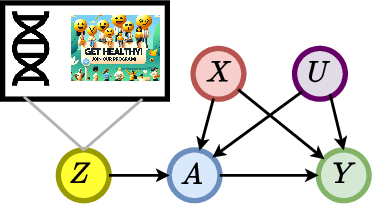
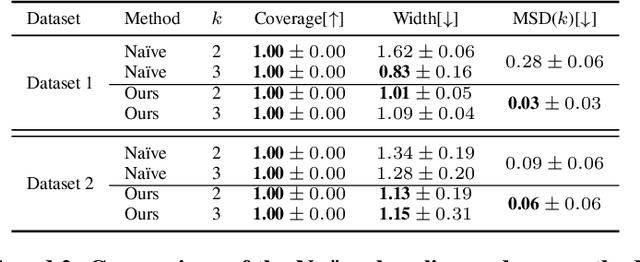
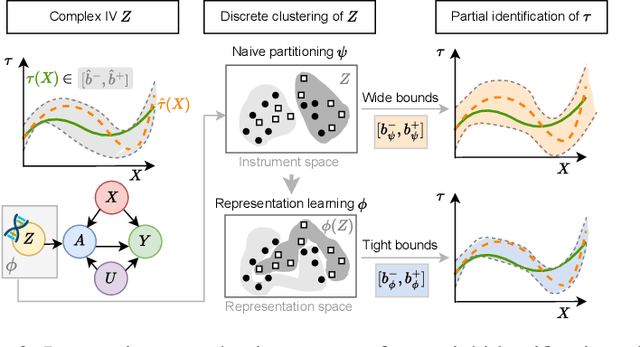

Abstract:Reliable estimation of treatment effects from observational data is important in many disciplines such as medicine. However, estimation is challenging when unconfoundedness as a standard assumption in the causal inference literature is violated. In this work, we leverage arbitrary (potentially high-dimensional) instruments to estimate bounds on the conditional average treatment effect (CATE). Our contributions are three-fold: (1) We propose a novel approach for partial identification through a mapping of instruments to a discrete representation space so that we yield valid bounds on the CATE. This is crucial for reliable decision-making in real-world applications. (2) We derive a two-step procedure that learns tight bounds using a tailored neural partitioning of the latent instrument space. As a result, we avoid instability issues due to numerical approximations or adversarial training. Furthermore, our procedure aims to reduce the estimation variance in finite-sample settings to yield more reliable estimates. (3) We show theoretically that our procedure obtains valid bounds while reducing estimation variance. We further perform extensive experiments to demonstrate the effectiveness across various settings. Overall, our procedure offers a novel path for practitioners to make use of potentially high-dimensional instruments (e.g., as in Mendelian randomization).
Conformal Prediction for Causal Effects of Continuous Treatments
Jul 03, 2024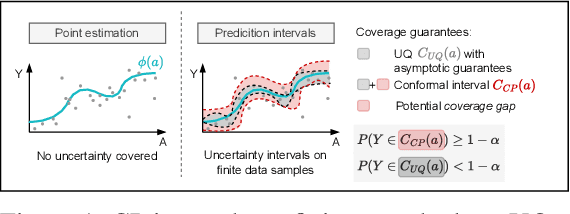

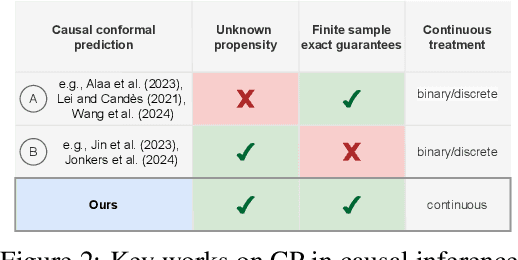

Abstract:Uncertainty quantification of causal effects is crucial for safety-critical applications such as personalized medicine. A powerful approach for this is conformal prediction, which has several practical benefits due to model-agnostic finite-sample guarantees. Yet, existing methods for conformal prediction of causal effects are limited to binary/discrete treatments and make highly restrictive assumptions such as known propensity scores. In this work, we provide a novel conformal prediction method for potential outcomes of continuous treatments. We account for the additional uncertainty introduced through propensity estimation so that our conformal prediction intervals are valid even if the propensity score is unknown. Our contributions are three-fold: (1) We derive finite-sample prediction intervals for potential outcomes of continuous treatments. (2) We provide an algorithm for calculating the derived intervals. (3) We demonstrate the effectiveness of the conformal prediction intervals in experiments on synthetic and real-world datasets. To the best of our knowledge, we are the first to propose conformal prediction for continuous treatments when the propensity score is unknown and must be estimated from data.
Causal Fairness under Unobserved Confounding: A Neural Sensitivity Framework
Nov 30, 2023Abstract:Fairness for machine learning predictions is widely required in practice for legal, ethical, and societal reasons. Existing work typically focuses on settings without unobserved confounding, even though unobserved confounding can lead to severe violations of causal fairness and, thus, unfair predictions. In this work, we analyze the sensitivity of causal fairness to unobserved confounding. Our contributions are three-fold. First, we derive bounds for causal fairness metrics under different sources of unobserved confounding. This enables practitioners to examine the sensitivity of their machine learning models to unobserved confounding in fairness-critical applications. Second, we propose a novel neural framework for learning fair predictions, which allows us to offer worst-case guarantees of the extent to which causal fairness can be violated due to unobserved confounding. Third, we demonstrate the effectiveness of our framework in a series of experiments, including a real-world case study about predicting prison sentences. To the best of our knowledge, ours is the first work to study causal fairness under unobserved confounding. To this end, our work is of direct practical value as a refutation strategy to ensure the fairness of predictions in high-stakes applications.
 Add to Chrome
Add to Chrome Add to Firefox
Add to Firefox Add to Edge
Add to Edge